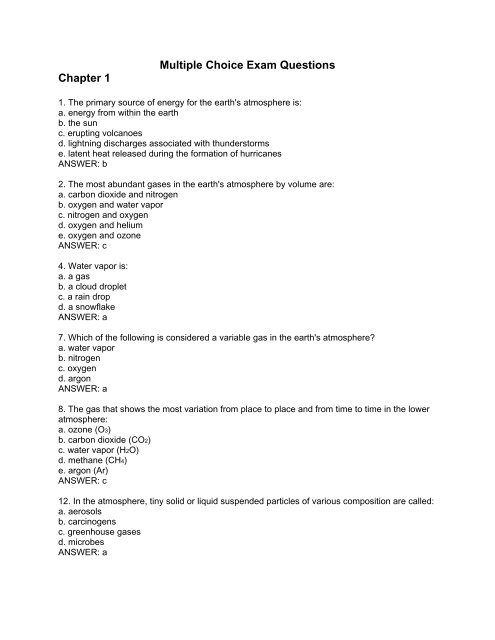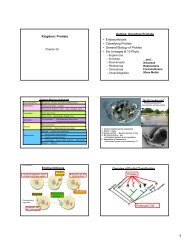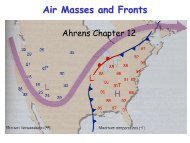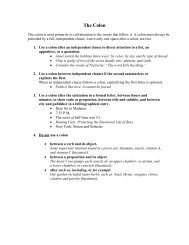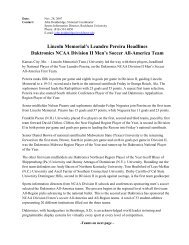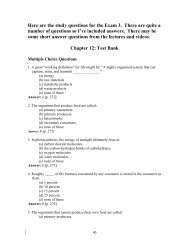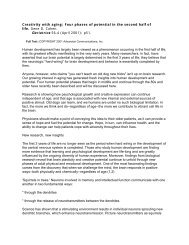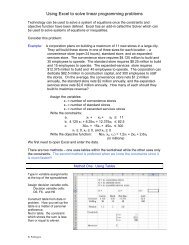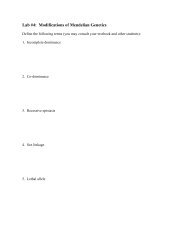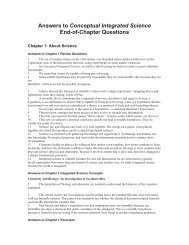Multiple Choice Exam Questions Chapter 1
Multiple Choice Exam Questions Chapter 1
Multiple Choice Exam Questions Chapter 1
Create successful ePaper yourself
Turn your PDF publications into a flip-book with our unique Google optimized e-Paper software.
<strong>Chapter</strong> 1<br />
<strong>Multiple</strong> <strong>Choice</strong> <strong>Exam</strong> <strong>Questions</strong><br />
1. The primary source of energy for the earth's atmosphere is:<br />
a. energy from within the earth<br />
b. the sun<br />
c. erupting volcanoes<br />
d. lightning discharges associated with thunderstorms<br />
e. latent heat released during the formation of hurricanes<br />
ANSWER: b<br />
2. The most abundant gases in the earth's atmosphere by volume are:<br />
a. carbon dioxide and nitrogen<br />
b. oxygen and water vapor<br />
c. nitrogen and oxygen<br />
d. oxygen and helium<br />
e. oxygen and ozone<br />
ANSWER: c<br />
4. Water vapor is:<br />
a. a gas<br />
b. a cloud droplet<br />
c. a rain drop<br />
d. a snowflake<br />
ANSWER: a<br />
7. Which of the following is considered a variable gas in the earth's atmosphere?<br />
a. water vapor<br />
b. nitrogen<br />
c. oxygen<br />
d. argon<br />
ANSWER: a<br />
8. The gas that shows the most variation from place to place and from time to time in the lower<br />
atmosphere:<br />
a. ozone (O3)<br />
b. carbon dioxide (CO2)<br />
c. water vapor (H2O)<br />
d. methane (CH4)<br />
e. argon (Ar)<br />
ANSWER: c<br />
12. In the atmosphere, tiny solid or liquid suspended particles of various composition are called:<br />
a. aerosols<br />
b. carcinogens<br />
c. greenhouse gases<br />
d. microbes<br />
ANSWER: a
13. The most abundant greenhouse gas in the earth's atmosphere:<br />
a. carbon dioxide (CO2)<br />
b. nitrous oxide (N2O)<br />
c. water vapor (H2O)<br />
d. methane (CH4)<br />
e. chlorofluorocarbons (CFCs)<br />
ANSWER: c<br />
17. Which of the following processes acts to remove carbon dioxide from the atmosphere?<br />
a. lightning<br />
b. deforestation<br />
c. photosynthesis<br />
d. burning fossil fuels<br />
ANSWER: c<br />
19. The earth's first atmosphere was composed primarily of:<br />
a. carbon dioxide and water vapor<br />
b. hydrogen and helium<br />
c. oxygen and water vapor<br />
d. argon and nitrogen<br />
ANSWER: b<br />
21. The most abundant gas emitted from volcanoes is:<br />
a. nitrogen<br />
b. sulfur dioxide<br />
c. helium<br />
d. carbon dioxide<br />
e. water vapor<br />
ANSWER: e<br />
23. This holds a planet's atmosphere close to its surface:<br />
a. radiation<br />
b. gravity<br />
c. cloud cover<br />
d. moisture<br />
e. pressure<br />
ANSWER: b<br />
24. The amount of force exerted over an area of surface is called:<br />
a. density<br />
b. weight<br />
c. temperature<br />
d. pressure<br />
ANSWER: d<br />
25. Much of Tibet lies at altitudes over 18,000 feet where the pressure is about 500 mb. At such<br />
altitudes, the Tibetans are above roughly:<br />
a. 10% of the air molecules in the atmosphere<br />
b. 25% of the air molecules in the atmosphere<br />
c. 50% of the air molecules in the atmosphere<br />
d. 75% of the air molecules in the atmosphere
ANSWER: c<br />
28. Which of the following weather elements always decreases as we climb upward in the<br />
atmosphere?<br />
a. wind<br />
b. temperature<br />
c. pressure<br />
d. moisture<br />
e. all of the above<br />
ANSWER: c<br />
32. The gas responsible for the greenhouse effect on Venus:<br />
a. carbon dioxide (CO2)<br />
b. oxygen (O2)<br />
c. ozone (O3)<br />
d. nitrogen (N2)<br />
e. water vapor (H2O)<br />
ANSWER: a<br />
33. The planet with a strong greenhouse effect, whose surface temperature averages 480 oC<br />
(900 oF):<br />
a. Earth<br />
b. Venus<br />
c. Mars<br />
d. Pluto<br />
ANSWER: b<br />
35. The earth's atmosphere is divided into layers based on the vertical profile of:<br />
a. air pressure<br />
b. air temperature<br />
c. air density<br />
d. wind speed<br />
ANSWER: b<br />
37. Almost all of the earth's weather occurs in the:<br />
a. exosphere<br />
b. stratosphere<br />
c. mesosphere<br />
d. thermosphere<br />
e. troposphere<br />
ANSWER: e<br />
39. The hottest atmospheric layer is the:<br />
a. stratosphere<br />
b. mesosphere<br />
c. thermosphere<br />
d. troposphere<br />
ANSWER: c
41. The atmospheric layer in which we live is called the:<br />
a. troposphere<br />
b. stratosphere<br />
c. thermosphere<br />
d. ionosphere<br />
e. exosphere<br />
ANSWER: a<br />
43. The instrument that measures temperature, pressure, and humidity at various altitudes in<br />
the atmosphere:<br />
a. barograph<br />
b. radiosonde<br />
c. aneroid barometer<br />
d. altimeter<br />
ANSWER: b<br />
44. Warming in the stratosphere is mainly caused by:<br />
a. absorption of ultraviolet radiation by ozone<br />
b. release of latent heat energy during condensation<br />
c. chemical reactions between ozone and chlorofluorocarbons<br />
d. frictional heating caused by meteorites<br />
ANSWER: a<br />
45. In a temperature inversion:<br />
a. air temperature increases with increasing height<br />
b. air temperature decreases with increasing height<br />
c. air temperature remains constant with increasing height<br />
d. it is warmer at night than during the day<br />
ANSWER: a<br />
46. The rate at which temperature decreases with increasing altitude is known as the:<br />
a. temperature slope<br />
b. lapse rate<br />
c. sounding<br />
d. thermocline<br />
ANSWER: b<br />
49. The electrified region of the upper atmosphere is called the:<br />
a. thermosphere<br />
b. mesosphere<br />
c. stratosphere<br />
d. ionosphere<br />
e. troposphere<br />
ANSWER: d<br />
52. The gas that absorbs most of the harmful ultraviolet radiation in the stratosphere:<br />
a. water vapor<br />
b. nitrous oxide<br />
c. carbon dioxide<br />
d. ozone<br />
e. chlorofluorocarbons
ANSWER: d<br />
55. Which latitude belt best describes the middle latitudes?<br />
a. 20o to 80o<br />
b. 10o to 35o<br />
c. 20o to 35o<br />
d. 40o to 70o<br />
e. 30o to 50o<br />
ANSWER: e<br />
58. The wind direction is:<br />
a. the direction from which the wind is blowing<br />
b. the direction to which the wind is blowing<br />
c. always directly from high toward low pressure<br />
d. always directly from low toward high pressure<br />
ANSWER: a<br />
77. In an average year, more people die from this than from any other natural disaster.<br />
a. lightning<br />
b. earthquakes<br />
c. tornadoes<br />
d. flash floods and flooding<br />
e. droughts<br />
ANSWER: d<br />
<strong>Chapter</strong> 2<br />
1. Which of the following provides a measure of the average speed of air molecules?<br />
a. pressure<br />
b. temperature<br />
c. density<br />
d. heat<br />
ANSWER: b<br />
3. Which of the following is not considered a temperature scale?<br />
a. Fahrenheit<br />
b. Kelvin<br />
c. Calorie<br />
d. Celsius<br />
ANSWER: c<br />
4. The temperature scale where 0o represents freezing and 100o boiling:<br />
a. Fahrenheit<br />
b. Celsius<br />
c. Kelvin<br />
d. absolute<br />
ANSWER: b
5. The temperature scale that sets freezing of pure water at 32o F:<br />
a. Kelvin<br />
b. Fahrenheit<br />
c. Celsius<br />
d. British<br />
ANSWER: b<br />
9. Heat is energy in the process of being transferred from:<br />
a. hot objects to cold objects<br />
b. low pressure to high pressure<br />
c. cold objects to hot objects<br />
d. high pressure to low pressure<br />
e. regions of low density toward regions of high density<br />
ANSWER: a<br />
10. The heat energy released when water vapor changes to a liquid is called:<br />
a. latent heat of evaporation<br />
b. latent heat of fusion<br />
c. latent heat of fission<br />
d. latent heat of condensation<br />
ANSWER: d<br />
11. The change of state of ice into water vapor is known as:<br />
a. deposition<br />
b. sublimation<br />
c. melting<br />
d. condensation<br />
e. crystallization<br />
ANSWER: b<br />
12. When water changes from a liquid to a vapor, we call this process:<br />
a. freezing<br />
b. condensation<br />
c. sublimation<br />
d. deposition<br />
e. evaporation<br />
ANSWER: e<br />
14. The cold feeling that you experience after leaving a swimming pool on a hot, dry, summer<br />
day represents heat transfer by:<br />
a. conduction<br />
b. convection<br />
c. radiation<br />
d. latent heat<br />
ANSWER: d<br />
16. The processes of condensation and freezing:<br />
a. both release sensible heat into the environment<br />
b. both absorb sensible heat from the environment<br />
c. do not affect the temperature of their surroundings<br />
d. do not involve energy transport
ANSWER: a<br />
17. The transfer of heat by molecule-to-molecule contact:<br />
a. conduction<br />
b. convection<br />
c. radiation<br />
d. ultrasonic<br />
ANSWER: a<br />
18. Which of the following is the poorest conductor of heat?<br />
a. still air<br />
b. water<br />
c. ice<br />
d. snow<br />
e. soil<br />
ANSWER: a<br />
19. The horizontal transport of any atmospheric property by the wind is called:<br />
a. advection<br />
b. radiation<br />
c. conduction<br />
d. latent heat<br />
e. reflection<br />
ANSWER: a<br />
20. A heat transfer process in the atmosphere that depends upon the movement of air is:<br />
a. conduction<br />
b. absorption<br />
c. reflection<br />
d. convection<br />
e. radiation<br />
ANSWER: d<br />
23. Rising air cools by this process:<br />
a. expansion<br />
b. evaporation<br />
c. compression<br />
d. condensation<br />
ANSWER: a<br />
25. The proper order from shortest to longest wavelength is:<br />
a. visible, infrared, ultraviolet<br />
b. infrared, visible, ultraviolet<br />
c. ultraviolet, visible, infrared<br />
d. visible, ultraviolet, infrared<br />
e. ultraviolet, infrared, visible<br />
ANSWER: c<br />
26. Sinking air warms by this process:<br />
a. compression<br />
b. expansion
c. condensation<br />
d. friction<br />
ANSWER: a<br />
27. Heat transferred outward from the surface of the moon can take place by:<br />
a. convection<br />
b. conduction<br />
c. latent heat<br />
d. radiation<br />
ANSWER: d<br />
29. If the average temperature of the sun increased, the wavelength of peak solar emission<br />
would:<br />
a. shift to a shorter wavelength<br />
b. shift to a longer wavelength<br />
c. remain the same<br />
d. impossible to tell from given information<br />
ANSWER: a<br />
30. Solar radiation reaches the earth's surface as:<br />
a. visible radiation only<br />
b. ultraviolet radiation only<br />
c. infrared radiation only<br />
d. visible and infrared radiation only<br />
e. ultraviolet, visible, and infrared radiation<br />
ANSWER: e<br />
31. Electromagnetic radiation with wavelengths between 0.4 and 0.7 micrometers is called:<br />
a. ultraviolet light<br />
b. visible light<br />
c. infrared light<br />
d. microwaves<br />
ANSWER: b<br />
33. The blueness of the sky is mainly due to:<br />
a. the scattering of sunlight by air molecules<br />
b. the presence of water vapor<br />
c. absorption of blue light by the air<br />
d. emission of blue light by the atmosphere<br />
ANSWER: a<br />
34. Which of the following determine the kind (wavelength) and amount of radiation that an<br />
object emits?<br />
a. temperature<br />
b. thermal conductivity<br />
c. density<br />
d. latent heat<br />
ANSWER: a
35. Often before sunrise on a clear, calm, cold morning, ice (frost) can be seen on the tops of<br />
parked cars, even when the air temperature is above freezing. This condition happens because<br />
the tops of the cars are cooling by:<br />
a. conduction<br />
b. convection<br />
c. latent heat<br />
d. radiation<br />
ANSWER: d<br />
37. Evaporation is a _________ process.<br />
a. cooling<br />
b. heating<br />
c. can’t tell - it depends on the temperature<br />
d. both a and c<br />
ANSWER: a<br />
38. If you want to keep an object cool while exposed to direct sunlight,<br />
a. put it inside a brown paper bag<br />
b. wrap it in black paper<br />
c. wrap it in aluminum foil with the shiny side facing inward<br />
d. wrap it in aluminum foil with the shiny side facing outward<br />
ANSWER: d<br />
39. Which of the following has a wavelength shorter than that of violet light?<br />
a. green light<br />
b. blue light<br />
c. infrared radiation<br />
d. red light<br />
e. ultraviolet radiation<br />
ANSWER: e<br />
40. If the absolute temperature of an object doubles, the maximum energy emitted goes up by a<br />
factor of:<br />
a. 2<br />
b. 4<br />
c. 8<br />
d. 16<br />
e. 32<br />
ANSWER: d<br />
42. How much radiant energy will an object emit if its temperature is at absolute zero?<br />
a. the maximum theoretical amount<br />
b. none<br />
c. the same as it would at any other temperature<br />
d. depends on the chemical composition of the object<br />
ANSWER: b<br />
43. Most of the radiation emitted by a human body is in the form of:<br />
a. ultraviolet radiation and is invisible<br />
b. visible radiation but is too weak to be visible<br />
c. infrared radiation and is invisible
d. humans do not emit electromagnetic radiation<br />
ANSWER: c<br />
45. The sun emits its greatest intensity of radiation in:<br />
a. the visible portion of the spectrum<br />
b. the infrared portion of the spectrum<br />
c. the ultraviolet portion of the spectrum<br />
d. the x-ray portion of the spectrum<br />
ANSWER: a<br />
47. The earth's radiation is often referred to as ________radiation, while the sun's radiation is<br />
often referred to as _________radiation.<br />
a. shortwave, longwave<br />
b. shortwave, shortwave<br />
c. longwave, shortwave<br />
d. longwave, longwave<br />
ANSWER: c<br />
50. The earth emits radiation with greatest intensity at:<br />
a. infrared wavelengths<br />
b. radio wavelengths<br />
c. visible wavelengths<br />
d. ultraviolet wavelengths<br />
ANSWER: a<br />
51. "A good absorber of a given wavelength of radiation is also a good emitter of that<br />
wavelength." This is a statement of:<br />
a. Stefan-Boltzmann's law<br />
b. Wien's Law<br />
c. Kirchoff's Law<br />
d. the First Law of Thermodynamics<br />
e. the Law of Relativity<br />
ANSWER: c<br />
54. Without the atmospheric greenhouse effect, the average surface temperature would be:<br />
a. higher than at present<br />
b. lower than at present<br />
c. the same as it is now<br />
d. much more variable than it is now<br />
ANSWER: b<br />
55. The earth's atmospheric window is in the:<br />
a. ultraviolet region<br />
b. visible region<br />
c. infrared region<br />
d. polar regions<br />
ANSWER: c<br />
56. The atmospheric greenhouse effect is produced mainly by the:<br />
a. absorption and re-emission of visible light by the atmosphere<br />
b. absorption and re-emission of ultraviolet radiation by the atmosphere
c. absorption and re-emission of infrared radiation by the atmosphere<br />
d. absorption and re-emission of visible light by clouds<br />
e. absorption and re-emission of visible light by the ground<br />
ANSWER: c<br />
57. Suppose last night was clear and calm. Tonight low clouds will be present. From this you<br />
would conclude that tonight's minimum temperature will be:<br />
a. higher than last night's minimum temperature<br />
b. lower than last night's minimum temperature<br />
c. the same as last night's minimum temperature<br />
d. above freezing<br />
ANSWER: a<br />
59. Low clouds retard surface cooling at night better than clear skies because:<br />
a. the clouds absorb and radiate infrared energy back to earth<br />
b. the water droplets in the clouds reflect infrared energy back to earth<br />
c. the clouds start convection currents between them<br />
d. the clouds are better conductors of heat than is the clear night air<br />
e. the formation of the clouds releases latent heat energy<br />
ANSWER: a<br />
60. At night, low clouds:<br />
a. enhance the atmospheric greenhouse effect<br />
b. weaken the atmospheric greenhouse effect<br />
c. are often caused by the atmospheric greenhouse effect<br />
d. have no effect on the atmospheric greenhouse effect<br />
ANSWER: a<br />
61. Which of the following gases are mainly responsible for the atmospheric greenhouse effect<br />
in the earth's atmosphere?<br />
a. oxygen and nitrogen<br />
b. nitrogen and carbon dioxide<br />
c. ozone and oxygen<br />
d. water vapor and carbon dioxide<br />
ANSWER: d<br />
63. The combined albedo of the earth and the atmosphere is approximately:<br />
a. 4%<br />
b. 10%<br />
c. 30%<br />
d. 50%<br />
e. 90%<br />
ANSWER: c<br />
64. According to the Stefan-Boltzmann law, the radiative energy emitted by one square meter of<br />
an object is equal to a constant multiplied by its temperature raised to the _______ power.<br />
a. negative third<br />
b. zeroeth<br />
c. fourth<br />
d. tenth<br />
ANSWER: c
67. The albedo of the earth's surface is only about 4%, yet the combined albedo of the earth<br />
and the atmosphere is about 30%. Which set of conditions below best explains why this is so?<br />
a. high albedo of clouds, low albedo of water<br />
b. high albedo of clouds, high albedo of water<br />
c. low albedo of clouds, low albedo of water<br />
d. low albedo of clouds, high albedo of water<br />
ANSWER: a<br />
68. According to Wein’s displacement law, the wavelength at which maximum radiation occurs<br />
a. is inversely proportional to the temperature<br />
b. is proportional to the temperature<br />
c. is inversely proportional to the pressure<br />
d. is proportional to the pressure<br />
ANSWER: a<br />
71. On the average, about what percentage of the solar energy that strikes the outer<br />
atmosphere eventually reaches the earth's surface?<br />
a. 5%<br />
b. 15%<br />
c. 30%<br />
d. 50%<br />
e. 70%<br />
ANSWER: d<br />
72. If the amount of energy lost by the earth to space each year were not approximately equal to<br />
that received:<br />
a. the atmosphere's average temperature would change<br />
b. the length of the year would change<br />
c. the sun's output would change<br />
d. the mass of the atmosphere would change<br />
ANSWER: a<br />
73. If the sun suddenly began emitting more energy, the earth's radiative equilibrium<br />
temperature would:<br />
a. increase<br />
b. decrease<br />
c. remain the same<br />
d. begin to oscillate<br />
ANSWER: a<br />
74. Sunlight that bounces off a surface is said to be ________ from the surface.<br />
a. radiated<br />
b. absorbed<br />
c. emitted<br />
d. reflected<br />
ANSWER: d<br />
77. The atmosphere near the earth's surface is "heated from below." Which of the following<br />
does not significantly contribute to this heating?<br />
a. conduction of heat upward from a hot surface<br />
b. convection from a hot surface
c. absorption of infrared energy that has been radiated from the surface<br />
d. heat energy from the earth's interior<br />
ANSWER: d<br />
78. The earth's radiative equilibrium temperature is:<br />
a. the temperature at which the earth is absorbing solar radiation and emitting<br />
infrared radiation at equal rates<br />
b. the temperature at which the earth is radiating energy at maximum intensity<br />
c. the average temperature the earth must maintain to prevent the oceans from<br />
freezing solid<br />
d. the temperature at which rates of evaporation and condensation on the earth are<br />
in balance<br />
ANSWER: a<br />
93. Sunlight passes through a thicker portion of the atmosphere at<br />
a. sunrise<br />
b. noon<br />
c. sunset<br />
d. night<br />
e. both a and c<br />
ANSWER: e<br />
95. A red shirt<br />
a. selectively absorbs red wavelenghts of visible light and scatters the rest<br />
b. selectively scatters red wavelenghts of visible light and absorbs the rest<br />
ANSWER: b<br />
96. Perspiration cools the body by<br />
a. advective heat transfer<br />
b. radiative heat transfer<br />
c. conductive heat transfet<br />
d. latent heat transfer<br />
ANSWER: d<br />
<strong>Chapter</strong> 3<br />
1. During the winter in the Northern Hemisphere, the "land of the midnight sun" would be found:<br />
a. at high latitudes<br />
b. at middle latitudes<br />
c. near the equator<br />
d. in the desert southwest<br />
e. on the West Coast<br />
ANSWER: a<br />
3. In the Northern Hemisphere, this day has the fewest hours of daylight:<br />
a. summer solstice<br />
b. winter solstice<br />
c. vernal equinox<br />
d. autumnal equinox<br />
ANSWER: b
4. During an equinox:<br />
a. the days and nights are of equal length except at the poles<br />
b. at noon the sun is overhead at the equator<br />
c. the earth is not tilted toward nor away from the sun<br />
d. all of the above<br />
ANSWER: d<br />
7. During the winter solstice in the Northern Hemisphere:<br />
a. astronomical winter begins in the Northern Hemisphere<br />
b. the noon sun is overhead at 23.5o S latitude<br />
c. at middle latitudes in the Northern Hemisphere, this marks the longest night of<br />
the year<br />
d. all of the above<br />
ANSWER: d<br />
10. Where are the days and nights of equal length all year long?<br />
a. at 66.5o<br />
b. nowhere<br />
c. at 23.5o<br />
d. at the Equator<br />
ANSWER: d<br />
12. Which of the following helps to explain why even though northern latitudes experience 24<br />
hours of sunlight on June 22, they are not warmer than latitudes further south?<br />
a. solar energy is spread over a larger area in northern latitudes<br />
b. some of the sun's energy is reflected by snow and ice in the northern latitudes<br />
c. increased cloud cover reflects solar energy in the northern latitudes<br />
d. solar energy is used to melt frozen soil in the northern latitudes<br />
e. all of the above<br />
ANSWER: e<br />
15. The north-facing side of a hill in a mountainous region in the US tends to:<br />
a. receive less sunlight during a year than the south-facing side<br />
b. grow a variety of trees that are typically observed at higher elevation<br />
c. be a better location for a ski run than the south-facing side<br />
d. have snow on the ground for a longer period of time in winter compared to the<br />
south-facing side<br />
e. all of the above<br />
ANSWER: e<br />
17. The maximum in daytime surface temperature typically occurs _______ the earth receives<br />
its most intense solar radiation.<br />
a. before<br />
b. after<br />
c. exactly when<br />
ANSWER: b<br />
19. The strongest radiation inversions occur when<br />
a. skies are overcast<br />
b. skies are partly cloudy
c. skies are clear<br />
d. precipitation is falling<br />
ANSWER: c<br />
20. When it is January and winter in the Northern Hemisphere, it is ______and ________in the<br />
SouthernHemisphere.<br />
a. January and summer<br />
b. January and winter<br />
c. July and winter<br />
d. July and summer<br />
ANSWER: a<br />
21. The most important reason why summers in the Southern Hemisphere are not warmer than<br />
summers in the Northern Hemisphere is that:<br />
a. the earth is closer to the sun in January<br />
b. the earth is farther from the sun in July<br />
c. over 80% of the Southern Hemisphere is covered with water<br />
d. the sun's energy is less intense in the Southern Hemisphere<br />
ANSWER: c<br />
23. Thermal belts are usually found<br />
a. on valley floors<br />
b. on hillsides<br />
c. on mountain tops<br />
ANSWER: b<br />
25. During a radiation inversion, wind machines<br />
a. bring warm air down toward the surface<br />
b. lift cool, surface air to higher altitudes<br />
c. mix the air near the ground<br />
d. all of the above<br />
ANSWER: d<br />
26. The main reason(s) for warm summers in northern middle latitudes is that:<br />
a. the earth is closer to the sun in summer<br />
b. the sun is higher in the sky and we receive more direct solar radiation<br />
c. the days are longer<br />
d. all of the above<br />
e. only (b) and (c) are correct<br />
ANSWER: e<br />
27. Our seasons are caused by:<br />
a. the changing distance between the earth and the sun<br />
b. the angle at which sunlight reaches the earth<br />
c. the length of the daylight hours<br />
d. all of the above<br />
e. only (b) and (c) are correct<br />
ANSWER: e
31. The earth is tilted at an angle of 23.5o with respect to the plane of its orbit around the sun. If<br />
the amount of tilt were increased to 40o, we would expect in middle latitudes:<br />
a. hotter summers and colder winters than at present<br />
b. cooler summers and milder winters than at present<br />
c. hotter summers and milder winters than at present<br />
d. cooler summers and colder winters than at present<br />
e. no appreciable change from present conditions<br />
ANSWER: a<br />
33. Although the polar regions radiate away more heat energy than they receive by insolation in<br />
the course of a year, they are prevented from becoming progressively colder each year by the:<br />
a. conduction of heat through the interior of the earth<br />
b. concentration of earth's magnetic field lines at the poles<br />
c. circulation of heat by the atmosphere and oceans<br />
d. the insulating properties of snow<br />
e. release of latent heat to the atmosphere when polar ice melts<br />
ANSWER: c<br />
37. In meteorology, the word insolation refers to:<br />
a. a well-constructed, energy-efficient home<br />
b. the solar constant<br />
c. incoming solar radiation<br />
d. an increase in solar output<br />
ANSWER: c<br />
38. During the afternoon the greatest temperature difference between the surface air and the air<br />
several meters above occurs on a:<br />
a. clear, calm afternoon<br />
b. clear, windy afternoon<br />
c. cloudy, calm afternoon<br />
d. cloudy, windy afternoon<br />
ANSWER: a<br />
39. The greatest variation in daily temperature usually occurs:<br />
a. at the ground<br />
b. about 5 feet above the ground<br />
c. at the top of a high-rise apartment complex<br />
d. at the level where thermals stop rising<br />
ANSWER: a<br />
40. In most areas the warmest time of the day about 5 feet above the ground occurs:<br />
a. around noon<br />
b. in the afternoon between 2 and 5 pm<br />
c. in the early evening after 6 pm<br />
d. just before the sun sets<br />
ANSWER: b<br />
42. The lowest temperature is usually observed:<br />
a. at the time of sunset<br />
b. near midnight<br />
c. several hours before sunrise
d. around sunrise<br />
e. several hours after sunrise<br />
ANSWER: d<br />
44. Suppose yesterday morning you noticed ice crystals (frost) on the grass, yet the minimum<br />
temperature reported in the newspaper was only 35o F. The most likely reason for this apparent<br />
discrepancy is that:<br />
a. temperature readings are taken in instrument shelters more than 5 feet above<br />
the ground<br />
b. the thermometer was in error<br />
c. the newspaper reported the wrong temperature<br />
d. the thermometer was read before the minimum temperature was reached for<br />
that day<br />
e. the thermometer was read incorrectly<br />
ANSWER: a<br />
46. At what time during a 24-hour day would a radiation temperature inversion best be<br />
developed?<br />
a. at sunset<br />
b. near sunrise<br />
c. toward the end of the morning<br />
d. between 2 and 5 pm when the air temperature reaches a maximum<br />
ANSWER: b<br />
47. The lag in daily temperature refers to the time lag between the:<br />
a. time of maximum solar radiation and the time of maximum temperature<br />
b. time of minimum temperature and the time of maximum solar radiation<br />
c. minimum and maximum temperature for a day<br />
d. minimum and maximum solar energy received at the surface for a given day<br />
e. sunrise and sunset<br />
ANSWER: a<br />
48. Ideal conditions for a strong radiation inversion:<br />
a. clear, calm, dry, winter night<br />
b. clear, calm, moist, summer night<br />
c. cloudy, calm, moist, winter night<br />
d. cloudy, windy, moist, summer night<br />
e. clear, windy, dry, summer night<br />
ANSWER: a<br />
49. Thermal belts are:<br />
a. pockets of warm air resting on a valley during the afternoon<br />
b. pockets of cold air resting on a valley floor at night<br />
c. warmer hillsides that are less likely to experience freezing conditions<br />
d. cold, below-freezing air found at the top of a mountain<br />
ANSWER: c<br />
50. The primary cause of a radiation inversion is:<br />
a. infrared radiation emitted by the earth's surface<br />
b. infrared radiation absorbed by the earth's surface<br />
c. solar radiation absorbed by the earth's surface
d. solar radiation reflected by the earth's surface<br />
e. infrared radiation absorbed by the atmosphere and clouds<br />
ANSWER: a<br />
51. The deepest radiation inversion would be observed:<br />
a. at the equator any day of the year<br />
b. in polar regions in winter<br />
c. at the top of a high mountain in winter<br />
d. on a desert in winter<br />
e. in a deep valley during the summer<br />
ANSWER: b<br />
53. On a clear, calm, night, the ground and air above cool mainly by this process:<br />
a. evaporation<br />
b. reflection<br />
c. convection<br />
d. conduction<br />
e. radiation<br />
ANSWER: e<br />
54. Which of the following can be used as a method of protecting an orchard from damaging low<br />
temperatures during a radiation inversion?<br />
a. orchard heaters<br />
b. wind machines<br />
c. irrigation (cover the area with water)<br />
d. all of the above<br />
ANSWER: d<br />
57. Lines connecting points of equal temperature are called:<br />
a. isobars<br />
b. isotherms<br />
c. thermals<br />
d. thermographs<br />
ANSWER: b<br />
58. In summer, humid regions typically have ________daily temperature ranges and<br />
_______maximum temperatures than drier regions.<br />
a. smaller, lower<br />
b. smaller, higher<br />
c. larger, lower<br />
d. larger, higher<br />
ANSWER: a<br />
62. An important reason for the large daily temperature range over deserts is:<br />
a. there is little water vapor in the air to absorb and re-radiate infrared radiation<br />
b. the light-colored sand radiates heat very rapidly at night<br />
c. dry air is a very poor heat conductor<br />
d. free convection cells are unable to form above the hot desert ground<br />
e. the ozone content of desert air is very low<br />
ANSWER: a
64. Two objects A and B have the same mass but the specific heat of A is larger than B. If both<br />
objects absorb equal amounts of energy:<br />
a. A will become warmer than B<br />
b. B will become warmer than A<br />
c. both A and B will warm at the same rate<br />
d. A will get warmer, but B will get colder<br />
ANSWER: b<br />
65. The largest annual ranges of temperatures are found:<br />
a. at polar latitudes over land<br />
b. at polar latitudes over water<br />
c. at middle latitudes near large bodies of water<br />
d. at the Equator<br />
e. in the Northern Central Plains of the United States<br />
ANSWER: a<br />
67. This is used as a guide to planting and for determining the approximate date for harvesting<br />
crops:<br />
a. growing degree-days<br />
b. heating degree-days<br />
c. cooling degree-days<br />
d. mean annual temperature<br />
ANSWER: a<br />
68. This is used as an index for fuel consumption:<br />
a. growing degree-days<br />
b. consumer price index<br />
c. heating degree-days<br />
d. mean annual temperature<br />
ANSWER: c<br />
69. Which of the following is not a reason why water warms and cools much more slowly than<br />
land?<br />
a. solar energy penetrates more deeply into water<br />
b. heat energy is mixed in a deeper layer of water<br />
c. water has a higher heat capacity<br />
d. a portion of the solar energy that strikes water is used to evaporate it<br />
e. it takes more heat to raise the temperature of a given amount of soil 1o C than<br />
it does to raise the temperature of water 1o C.<br />
ANSWER: e<br />
74. In calm air the air temperature is -10o C, if the wind speed should increase to 30 knots (with<br />
no change in air temperature) the thermometer would indicate:<br />
a. a much higher temperature than -10o C<br />
b. a much lower temperature than -10o C<br />
c. a temperature of -10o C<br />
d. a temperature of -30o C<br />
ANSWER: c
75. The air temperature is 45o F, the wind is blowing at 30 MPH, and the wind chill temperature<br />
is 15o F. These conditions would be equivalent to:<br />
a. a 15o F air temperature and 0 MPH winds<br />
b. a 30o F air temperature and 45 MPH winds<br />
c. a 30o F air temperature and 15 MPH winds<br />
d. a 15o F air temperature and 30 MPH winds<br />
ANSWER: a<br />
76. Hypothermia is most common in:<br />
a. hot, humid weather<br />
b. cold, wet weather<br />
c. hot, dry weather<br />
d. cold, dry weather<br />
ANSWER: b<br />
78. The wind-chill factor:<br />
a. relates body heat loss with wind to an equivalent temperature with no wind<br />
b. indicates the temperature at which water freezes on exposed skin<br />
c. takes into account humidity and air temperature in expressing the current air<br />
temperature<br />
d. tells farmers when to protect crops from a freeze<br />
e. determines how low the air temperature will be on any given day<br />
ANSWER: a<br />
95. In the northern hemisphere, the number of hours of daylight begin to shorten after the<br />
a. spring equinox<br />
b. summer solstice<br />
c. autumn equinox<br />
d. winter solstice<br />
ANSWER: b<br />
96. At any given time, ______ of the earth is illuminated by the sun.<br />
a. one-fourth<br />
b. one-third<br />
c. one-half<br />
d. two-thirds<br />
ANSWER: c<br />
103. Water heats up ______ and cools off _____ than land.<br />
a. more quickly, more quickly<br />
b. more quickly, more slowly<br />
c. more slowly, more quickly<br />
d. more slowly, more slowly<br />
ANSWER: d<br />
<strong>Chapter</strong> 4<br />
1. If a glass of water were surrounded by saturated air:<br />
a. the level of the water in the glass would slowly decrease<br />
b. the water's temperature would slowly increase
c. the level of the water in the glass would not change<br />
d. the water's temperature would slowly decrease<br />
ANSWER: c<br />
3. As the air temperature increases, the air's capacity for water vapor:<br />
a. increases<br />
b. decreases<br />
c. remains constant<br />
d. is unrelated to air temperature and can either increase or decrease<br />
ANSWER: a<br />
4. If all the water vapor in the atmosphere were to condense and fall to the ground, the globe<br />
would be covered with about of water.<br />
a. 1 millimeter<br />
b. 1 inch<br />
c. 1 foot<br />
d. 1 meter<br />
ANSWER: b<br />
5. The total mass of water vapor stored in the atmosphere at any moment is about ________of<br />
the world's supply of precipitation.<br />
a. 1 day<br />
b. 1 week<br />
c. 1 month<br />
d. 1 year<br />
ANSWER: b<br />
7. The density of water vapor in a given parcel of air is expressed by the:<br />
a. absolute humidity<br />
b. relative humidity<br />
c. mixing ratio<br />
d. specific humidity<br />
e. saturation vapor pressure<br />
ANSWER: a<br />
8. Which of the following will increase in a rising parcel of air?<br />
a. saturation vapor pressure<br />
b. relative humidity<br />
c. mixing ratio<br />
d. air temperature<br />
e. none of the above<br />
ANSWER: b<br />
9. Which of the following will decrease in a rising parcel of air?<br />
a. relative humidity<br />
b. absolute humidity<br />
c. specific humidity<br />
d. all of the above<br />
ANSWER: b
10. The ratio of the mass of water vapor in a given volume (parcel) of air to the mass of the<br />
remaining dry air describes the:<br />
a. absolute humidity<br />
b. mixing ratio<br />
c. relative humidity<br />
d. dew point<br />
ANSWER: b<br />
11. When the air temperature increases, the saturation vapor pressure will:<br />
a. increase<br />
b. decrease<br />
c. remain the same<br />
d. vary over an increasingly broad range of values<br />
ANSWER: a<br />
12. The maximum pressure that water vapor molecules would exert if the air were saturated is<br />
called the:<br />
a. absolute humidity<br />
b. boiling point<br />
c. mixing ratio<br />
d. none of the above<br />
ANSWER: d<br />
13. If water vapor comprises 3.5% of an air parcel whose total pressure is 1000 mb, the water<br />
vapor pressure would be:<br />
a. 1035 mb<br />
b. 35 mb<br />
c. 350 mb<br />
d. 965 mb<br />
ANSWER: b<br />
15. If the air temperature increased, with no addition or removal of water vapor, the actual vapor<br />
pressure would:<br />
a. increase<br />
b. decrease<br />
c. stay the same<br />
d. become greater than the saturation vapor pressure<br />
ANSWER: c<br />
16. When the air temperature is below freezing, the saturation vapor pressure over water is .<br />
a. equal to zero<br />
b. less than the saturation vapor pressure over ice<br />
c. greater than the saturation vapor pressure over ice<br />
d. equal to the saturation vapor pressure over ice<br />
ANSWER: c<br />
19. The Gulf Coast states are more humid in summer than the coastal areas of Southern<br />
California mainly because of the:<br />
a. higher air temperature in the Gulf States<br />
b. lower air temperature in Southern California<br />
c. higher water temperature in the Gulf of Mexico
d. low relative humidity of the air over the Pacific Ocean<br />
ANSWER: c<br />
20. If very cold air is brought indoors and warmed with no change in its moisture content, the<br />
saturation vapor pressure of this air will______ and the relative humidity of this air will_____ .<br />
a. increase, increase<br />
b. decrease, decrease<br />
c. increase, decrease<br />
d. decrease, increase<br />
ANSWER: c<br />
27. The main reason why vegetables take longer to cook in boiling water at high altitudes is<br />
because:<br />
a. water boils at a higher temperature with higher altitude<br />
b. the temperature of the boiling water decreases with increasing altitude<br />
c. there is less oxygen in the air at high altitude<br />
d. saturation vapor pressure decreases with increasing altitude<br />
ANSWER: b<br />
28. The temperature at which water boils depends mainly on:<br />
a. air temperature<br />
b. relative humidity<br />
c. air pressure<br />
d. air density<br />
e. the specific heat of air<br />
ANSWER: c<br />
29. The percentage of water vapor present in the air compared to that required for saturation is<br />
the:<br />
a. mixing ratio<br />
b. absolute humidity<br />
c. dew point<br />
d. relative humidity<br />
e. specific humidity<br />
ANSWER: d<br />
31. At what time of day is the relative humidity normally at a minimum?<br />
a. when the air temperature is highest<br />
b. just before sunrise<br />
c. about midnight<br />
d. when the air temperature is lowest<br />
ANSWER: a<br />
32. The time of day when the relative humidity reaches a maximum value is usually:<br />
a. at the time when the air temperature is highest<br />
b. in the middle of the afternoon<br />
c. at the time when the air temperature is lowest<br />
d. just before sunrise<br />
e. about midnight<br />
ANSWER: c
33. The dew point temperature is a measure of the total amount of water vapor in the air.<br />
a. true<br />
b. false<br />
ANSWER: a<br />
34. As the air temperature increases, with no addition of water vapor to the air, the relative<br />
humidity will:<br />
a. remain the same<br />
b. increase<br />
c. decrease<br />
d. increase until it becomes equal to the dew point temperature<br />
ANSWER: c<br />
40. Suppose saturated polar air has an air temperature and dew point of -10o C, and<br />
unsaturated desert air has an air temperature of 35o C and a dew point of 10o C. The desert air<br />
contains ______water vapor and has a ________relative humidity than the polar air.<br />
a. more, lower<br />
b. more, higher<br />
c. less, lower<br />
d. less, higher<br />
ANSWER: a<br />
42. As the difference between the air temperature and the dew point increases, the relative<br />
humidity:<br />
a. increases<br />
b. decreases<br />
c. remains constant at a value less than 100%<br />
d. remains constant and equal to 100%<br />
ANSWER: b<br />
43. The temperature to which air must be cooled in order to become saturated is the:<br />
a. minimum temperature<br />
b. dew point temperature<br />
c. wet-bulb temperature<br />
d. freezing point<br />
ANSWER: b<br />
44. As the air temperature increases, with no addition of water vapor to the air, the dew point<br />
will:<br />
a. remain the same<br />
b. increase<br />
c. decrease<br />
d. increase and become equal to the air temperature<br />
ANSWER: a<br />
52. Nighttime temperatures rarely drop below the dew point temperature because<br />
a. the dew will absorb all the heat<br />
b. saturation vapor pressures always increase at night<br />
c. at saturation, latent heat of condensation is released into the air<br />
d. both (b) and (c)<br />
ANSWER: c


